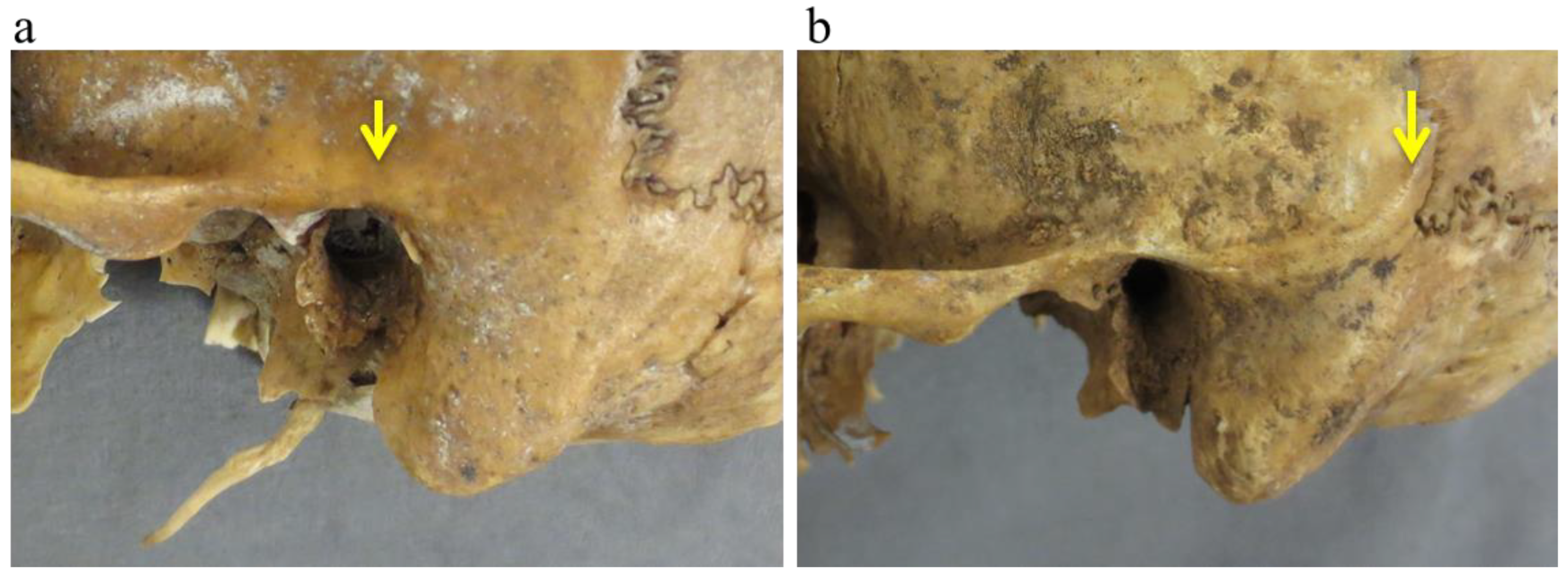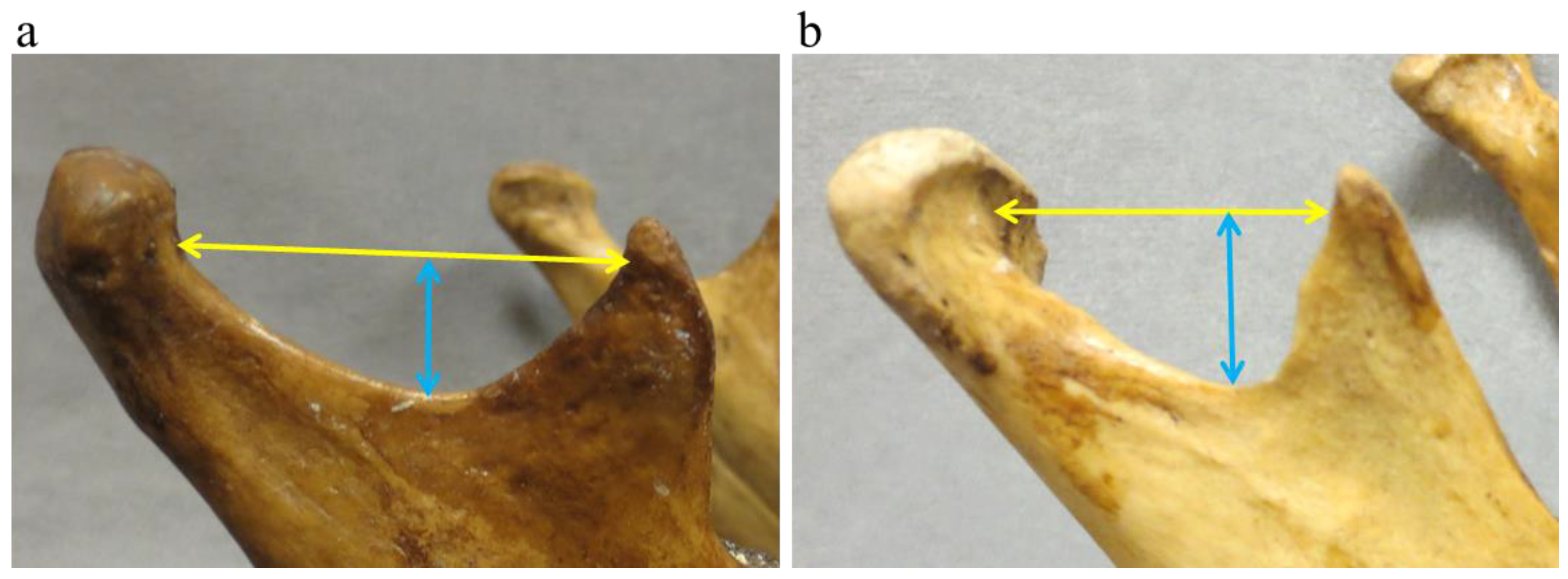Evaluation of the Potential Use of Four Skull Traits for Sex Estimation
Abstract
1. Introduction
2. Material and Methods
3. Results
4. Discussion
Author Contributions
Funding
Institutional Review Board Statement
Informed Consent Statement
Data Availability Statement
Acknowledgments
Conflicts of Interest
References
- Bruzek, J.; Murail, P. Methodology and reliability of sex determination from the skeleton. In Forensic Anthropology and Medicine: Complementary Sciences from Recovery to Cause of Death; Schmitt, A., Cunha, E., Pinheiro, J., Eds.; Humana Press: Totowa, NJ, USA, 2006; pp. 225–242. [Google Scholar] [CrossRef]
- Nowaczewska, W.; Kubicka, A.M.; Piontek, J.; Biecek, P. Sex estimation from dimensions of the base of the skull in Black South Africans. Anthropol. Anz. 2022, 79, 153–164. [Google Scholar] [CrossRef]
- Franklin, D.; O’HIggins, P.; Oxnard, C.E.; Dadour, I. Determination of sex in South African blacks by discriminant function analysis of mandibular linear dimensions: A preliminary investigation using the Zulu local population. Forensic Sci. Med. Pathol. 2014, 2, 263–268. [Google Scholar]
- Zhang, M. The application of forensic imaging to sex estimation: Focus on skull and pelvic structures. Perspect. Leg. Forensic Sci. 2024, 1, 10005. Available online: https://www.sciepublish.com/article/pii/186 (accessed on 15 October 2025). [CrossRef]
- Walker, P.L. Sexing skulls using discriminant function analysis of visual assessed traits. Am. J. Phys. Anthr. 2008, 136, 39–50. [Google Scholar] [CrossRef] [PubMed]
- González, P.N.; Bernal, V.; Pérez, S.I. Geometric morphometric approach to sex estimation of human pelvis. Forensic Sci. Int. 2009, 189, 68.e1–68.e8. [Google Scholar] [CrossRef]
- Klales, A.R. Current state of sex estimation in forensic anthropology. Forensic Anthropol. 2021, 4, 219–230. [Google Scholar] [CrossRef]
- Klales, A.R.; Lesciotto, K.M. Reevaluating skeletal sex estimation practices in forensic anthropology. J. Forensic Sci. 2025, 70, 825–834. [Google Scholar] [CrossRef] [PubMed]
- Mello-Gentil, T.; Souza-Mello, V. Contributions of anatomy to forensic sex estimation: Focus on head and neck bones. Forensic Sci. Res. 2021, 7, 11–23. [Google Scholar] [CrossRef]
- Wang, X.; Liu, G.; Wu, Q.; Zheng, Y.; Song, F.; Li, Y. Sex estimation techniques based on skulls in forensic anthropology: A scoping review. PLoS ONE 2024, 19, e0311762. [Google Scholar] [CrossRef]
- Krogman, W.M. The Human Skeleton in Forensic Medicine; Charles C. Thomas: Springfield, MO, USA, 1962. [Google Scholar]
- Barrio, P.A.; Trancho, G.J.; Sánchez, A. Metacarpal sexual determination in a Spanish population. J. Forensic Sci. 2006, 51, 990–995. [Google Scholar] [CrossRef]
- Mastrangelo, P.; de Luca, S.; Sánchez-Mejorada, G. Sex assessment from carpal bones: Discriminant function analysis in a contemporary Mexican sample. Forensic Sci. Int. 2011, 209, 196.e1–196.e15. [Google Scholar] [CrossRef]
- Black, S.; Ferguson, E. Forensic Anthropology 2000 to 2010; CRC Press: Boca Raton, FL, USA, 2011. [Google Scholar]
- Spence, T.F. The Anatomical Study of Cremated Fragments from Archaeological Sites. Proc. Prehist. Soc. 1967, 5, 70–83. [Google Scholar] [CrossRef]
- Ibrahim, J.; Brumfeld, V.; Addadi, Y.; Rubin, S.; Weiner, S.; Boaretto, E. The petrous bone contains high concentrations of osteocytes: One possible reason why ancient DNA is better preserved in this bone. PLoS ONE 2022, 17, e0269348. [Google Scholar] [CrossRef] [PubMed] [PubMed Central]
- Dokládal, M. Über die Heutigen Möglichkeiten der Personenidentifikation auf Grund von Verbrannten Knochen. In Aktuelle Kriminologie; Kriminalistik Verlag: Heidelberg, Germany, 1969; pp. 223–246. [Google Scholar]
- Lewis, C.J.; Garvin, H.M. Reliability of the Walker Cranial Nonmetric Method and Implications for Sex Estimation. J. Forensic Sci. 2016, 61, 743–751. [Google Scholar] [CrossRef]
- Krüger, G.C.; L’Abbe, E.N.; Stull, K.E.; Kenyhercz, M.W. Sexual dimorphism in cranial morphology among modern South Africans. Int. J. Leg. Med. 2014, 129, 869–875. [Google Scholar] [CrossRef]
- Oikonomopoulou, E.K.; Valakos, E.; Nikita, E. Population-specificity of sexual dimorphism in cranial and pelvic traits. Int. J. Leg. Med. 2017, 131, 1731–1738. [Google Scholar] [CrossRef]
- Acsádi, G.; Nemeskéri, J. History of Human Life Span and Mortality; Akadémiai Kiado: Budapest, Hungary, 1970. [Google Scholar]
- Garvin, H.M.; Ruff, C.B. Sexual dimorphism in skeletal browridge and chin morphologies determined using a new quantitative method. Am. J. Phys. Anthr. 2012, 147, 661–670. [Google Scholar] [CrossRef] [PubMed]
- Garvin, H.M.; Sholts, S.B.; Mosca, L.A. Sexual dimorphism in human cranial trait scores: Effects of population, age, and body size. Am. J. Phys. Anthropol. 2014, 154, 259–269. [Google Scholar] [CrossRef]
- Stevenson, J.C.; Mahoney, E.R.; Walker, P.L.; Everson, P.M. Technical note: Prediction of sex based on five skull traits using decision analysis (CHAID). Am. J. Phys. Anthr. 2009, 139, 434–441. [Google Scholar] [CrossRef] [PubMed]
- Waldron, T. The relative survival of the human skeleton: Implications for palaeopathology. In Death, Decay and Reconstruction; Manchester University Press: Manchester, UK, 1987; pp. 55–64. [Google Scholar]
- Günay, Y.; Altinkök, M. The value of the size of foramen magnum in sex determination. J. Clin. Forensic Med. 2000, 7, 147–149. [Google Scholar] [CrossRef]
- Uysal, S.; Gokharman, D.; Kacar, M.; Tuncbilek, I.; Kosar, U. Estimation of sex by 3D CT measurements of the foramen magnum. J. Forensic Sci. 2005, 50, 1310–1314. [Google Scholar] [CrossRef]
- Catalina-Herrera, C.J. Study of the anatomic metric values of the foramen magnum and its relation to sex. Acta Anat. 1987, 130, 344–347. [Google Scholar] [CrossRef] [PubMed]
- Basso, I.B.; Freitas, P.F.d.J.; Ferraz, A.X.; Borkovski, A.J.; Santos, R.S.; Rached, R.N.; Küchler, E.C.; Schroder, A.G.D.; de Araujo, C.M.; Guariza-Filho, O. Sex prediction through machine learning utilizing mandibular condyles, coronoid processes, and sigmoid notches features. PLoS ONE 2024, 19, e0312824. [Google Scholar] [CrossRef] [PubMed]
- Langley, N.R.; Dudzik, B.; Cloutier, A. A Decision Tree for Nonmetric Sex Assessment from the Skull. J. Forensic Sci. 2018, 63, 31–37. [Google Scholar] [CrossRef]
- Gruber, P.; Henneberg, M.; Böni, T.; Rühli, F.J. Variability of Human Foramen Magnum Size. Anat. Rec. 2009, 292, 1713–1719. [Google Scholar] [CrossRef]
- Uthman, A.; Al-Rawi, N.; Al-Timimi, J. Evaluation of foramen magnum in gender determination using helical CT. Dentomaxillofacial Radiol. 2012, 41, 197–202. [Google Scholar] [CrossRef]
- Gapert, R.; Black, S.; Last, J. Sex determination from the foramen magnum: Discriminant function analysis. Int. J. Leg. Med. 2009, 123, 25–33. [Google Scholar] [CrossRef] [PubMed]
- Rogers, T.L. Determining the sex of human remains through cranial morphology. J. Forensic Sci. 2005, 50, 493–500. [Google Scholar] [CrossRef]
- Monticelli, F.; Graw, M. Investigation on the reliability of determining sex from the human os zygomaticum. Forensic Sci. Med. Pathol. 2008, 4, 181–186. [Google Scholar] [CrossRef]
- Poongodi, V.; Kanmani, R.; Anandi, M.S.; Krithika, C.L.; Kannan, A.; Raghuram, P.H. Prediction of age and gender using digital radiographic method. J. Pharm. Bioallied Sci. 2015, 7 (Suppl. 2), S504–S508. [Google Scholar] [CrossRef]
- Kharoshah, M.A.; Almadani, O.; Ghaleb, S.S.; Zaki, M.K.; Fattah, Y.A.A. Sexual dimorphism of the mandible in a modern Egyptian population. J. Forensic Leg. Med. 2010, 17, 213–215. [Google Scholar] [CrossRef] [PubMed]
- Konigsberg, L.W.; Hens, S.M. Use of ordinal categorical variables in skeletal assessment of sex from the cranium. Am. J. Phys. Anthropol. 1998, 107, 97–112. [Google Scholar] [CrossRef]
- Steyn, M.; Isçan, M.Y. Sexual dimorphism in the crania and mandibles of South African whites. Forensic Sci. Int. 1998, 98, 9–16. [Google Scholar] [CrossRef] [PubMed]
- Saul, J.M.; Saul, F.P. Forensics, archaeology, and taphonomy: The symbiotic relationship. In Advances in Forensic Taphonomy: Method, Theory, and Archaeological Perspectives; Haglund, W.D., Sorg, M.H., Eds.; CRC Press: Boca Raton, FL, USA, 2001; pp. 63–73. [Google Scholar]




| FM Shape | ZAE | SN_Depth | SN_Wideness | GO | ||
|---|---|---|---|---|---|---|
| Females | 1 | 35 | 19 | 18 | 33 | 17 |
| 0 | 10 | 26 | 26 | 11 | 25 | |
| Males | 1 | 31 | 34 | 28 | 36 | 39 |
| 0 | 20 | 16 | 23 | 15 | 12 |
| Trait | Intraobserver 1 | CI | Intraobserver 2 | CI | Interobserver | CI |
|---|---|---|---|---|---|---|
| FM Shape | 0.958 | 95% (0.902–1.014) | 0.949 | 95% (0.924–0.966) | 0.958 | 95% (0.902–1.014) |
| SN Depth | 0.958 | 95% (0.902–1.014) | 0.948 | 95% (0.877–1.019) | 0.958 | 95% (0.902–1.014) |
| SN Wideness | 0.979 | 95% (0.94–0.973) | 0.979 | 95% (0.94–0.973) | 0.958 | 95% (0.902–1.014) |
| ZAE | 0.958 | 95% (0.902–1.014) | 0.979 | 95% (0.94–0.973) | 0.958 | 95% (0.902–1.014) |
| GO | 0.979 | 95% (0.94–0.973) | 0.979 | 95% (0.94–0.973) | 0.948 | 95% (0.877–1.019) |
| Sex | Result | Total | |||
|---|---|---|---|---|---|
| Male | Female | ||||
| Sample | number | Male | 42 | 12 | 54 |
| Female | 8 | 37 | 45 | ||
| % | Male | 77.8 | 22.2 | 100 | |
| Female | 17.8 | 82.2 | 100 | ||
| Total Success Rate (%) | 79.8 | ||||
Disclaimer/Publisher’s Note: The statements, opinions and data contained in all publications are solely those of the individual author(s) and contributor(s) and not of MDPI and/or the editor(s). MDPI and/or the editor(s) disclaim responsibility for any injury to people or property resulting from any ideas, methods, instructions or products referred to in the content. |
© 2025 by the authors. Licensee MDPI, Basel, Switzerland. This article is an open access article distributed under the terms and conditions of the Creative Commons Attribution (CC BY) license (https://creativecommons.org/licenses/by/4.0/).
Share and Cite
Adserias-Garriga, J.; Maijanen, H.; C. Zapico, S. Evaluation of the Potential Use of Four Skull Traits for Sex Estimation. Forensic Sci. 2025, 5, 60. https://doi.org/10.3390/forensicsci5040060
Adserias-Garriga J, Maijanen H, C. Zapico S. Evaluation of the Potential Use of Four Skull Traits for Sex Estimation. Forensic Sciences. 2025; 5(4):60. https://doi.org/10.3390/forensicsci5040060
Chicago/Turabian StyleAdserias-Garriga, Joe, Heli Maijanen, and Sara C. Zapico. 2025. "Evaluation of the Potential Use of Four Skull Traits for Sex Estimation" Forensic Sciences 5, no. 4: 60. https://doi.org/10.3390/forensicsci5040060
APA StyleAdserias-Garriga, J., Maijanen, H., & C. Zapico, S. (2025). Evaluation of the Potential Use of Four Skull Traits for Sex Estimation. Forensic Sciences, 5(4), 60. https://doi.org/10.3390/forensicsci5040060







